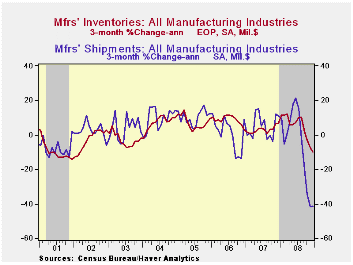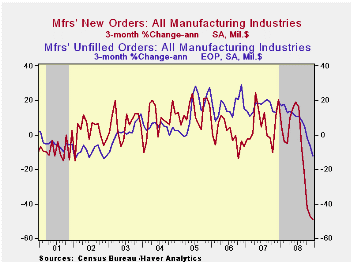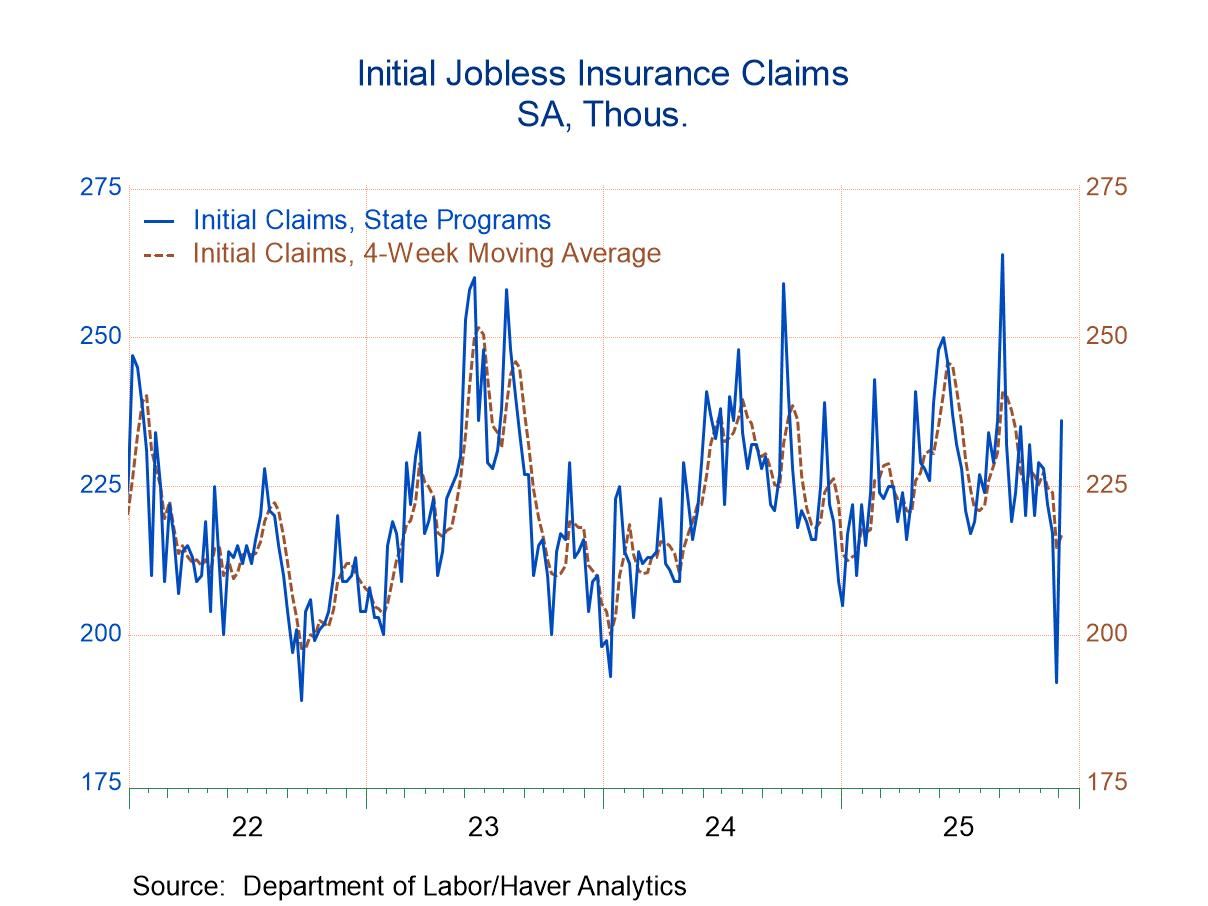 Global| Feb 05 2009
Global| Feb 05 2009U.S. Factory Inventories Lower Still
by:Tom Moeller
|in:Economy in Brief
Summary
The correction of factory inventory levels has picked up steam. In December, the 1.4% decline followed a 0.5% November drop that was roughly double the initial estimate of -0.3%. On a three-month basis, the rate of decline accelerated [...]

The correction of factory inventory levels has picked up steam. In December, the 1.4% decline followed a 0.5% November drop that was roughly double the initial estimate of -0.3%. On a three-month basis, the rate of decline accelerated to 9.7%. To be sure, these figures have been influenced by the decline in oil prices. However, a broad-based inventory correction in the factory sector still is underway. Less oil, factory inventories fell 0.5% during December. That lowered the three-month change to a negative 0.6% (AR) after 8% rates of growth earlier in 2008.
The commercial aircraft industry continued to dominate the nonoil industry figures with a positive 45.6% year-to-year growth rate. To the downside, automobile inventories have been reduced by 8.7% versus last year. Electrical equipment & appliance inventories grew at a 0.5% rate in December versus double-digit growth early in 2007 and growth in machinery inventories has been nearly halved to 6%. Steep production cutbacks pulled furniture inventories down 5.2%. The computer industry bucked the trend and inventories rose at a 6.8% rate last year versus slight decumulation in 2007.
Total factory orders dropped sharply again in December. The 3.9% decline was the fourth in a row between -3% and -7%, but that reflected the drop in oil prices (orders here equal shipments). Textile mill orders fell 4.2% (-18.2% y/y) and apparel orders fell 3.1% y/y. Orders for durable goods orders fell 3.0% reflecting the 43.8% drop in commercial aircraft orders. Less commercial aircraft, orders for durable goods fell 1.9% or 16.0% y/y.
Factory shipments dropped 2.9% due to lower oil prices. Less oil, shipments fell a lesser 1.3% but year-to-year they were down sharply by 7.4%. Automobile shipments were off by more than one quarter year-to-year and shipments of electrical equipment were off 9.7%. Electronic computer shipments fell 29.1% y/y with lower prices while shipments of furniture & related products fell 12.5%.
Total unfilled orders fell 1.4%, but less the transportation sector where aircraft backlogs still are strong, unfilled orders fell 2.2%.
Why Do Firms Use Temporary Workers? from the Federal Reserve Bank of Chicago is available here.
| Factory Survey (NAICS, %) | December | November | Y/Y | 2008 | 2007 | 2006 |
|---|---|---|---|---|---|---|
| Inventories | -1.4 | -0.5 | 2.6 | 2.6 | 3.7 | 8.2 |
| Excluding Transportation | -2.3 | -1.1 | -0.0 | -0.0 | 2.7 | 7.9 |
| New Orders | -3.9 | -6.5 | -18.7 | 0.2 | 1.9 | 6.2 |
| Excluding Transportation | -4.4 | -6.0 | -15.2 | 3.2 | 1.2 | 7.4 |
| Shipments | -2.9 | -6.5 | -12.8 | 1.8 | 1.2 | 5.9 |
| Excluding Transportation | -3.5 | -6.8 | -12.2 | 3.7 | 1.5 | 6.7 |
| Unfilled Orders | -1.4 | -0.9 | 3.7 | 3.7 | 17.1 | 15.3 |
| Excluding Transportation | -2.2 | -1.4 | -0.6 | -0.6 | 8.2 | 16.0 |
Tom Moeller
AuthorMore in Author Profile »Prior to joining Haver Analytics in 2000, Mr. Moeller worked as the Economist at Chancellor Capital Management from 1985 to 1999. There, he developed comprehensive economic forecasts and interpreted economic data for equity and fixed income portfolio managers. Also at Chancellor, Mr. Moeller worked as an equity analyst and was responsible for researching and rating companies in the economically sensitive automobile and housing industries for investment in Chancellor’s equity portfolio. Prior to joining Chancellor, Mr. Moeller was an Economist at Citibank from 1979 to 1984. He also analyzed pricing behavior in the metals industry for the Council on Wage and Price Stability in Washington, D.C. In 1999, Mr. Moeller received the award for most accurate forecast from the Forecasters' Club of New York. From 1990 to 1992 he was President of the New York Association for Business Economists. Mr. Moeller earned an M.B.A. in Finance from Fordham University, where he graduated in 1987. He holds a Bachelor of Arts in Economics from George Washington University.






